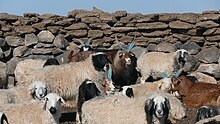Dsud
Dsud ( Mongolian Зуд ) is a Mongolian name for extreme meteorological conditions, especially in winter. A large number of animals then die from hunger or cold.
species
The locals differentiate between black, white and icy dsuds: The black dsud (хар зуд, char dsud ) is characterized by poor food in summer and a cold winter in which many animals die of hunger. The white dsud (цагаан зуд, tsagaan dsud ) is characterized by very heavy snowfall, which makes it impossible for the cattle to feed on the otherwise accessible frozen grass, so that they also starve to death. The ice dsud (мөсөн зуд, mösön dsud ), more rarely also called the iron dsud (төмөр зуд, tömör dsud ), is brought about by rain that freezes on the ground, covers the land with ice and thus prevents the animals from getting off the grass and herbs to feed. Fourth, there is the storm dsud (шуурган зуд, schuurgan dsud ).
Gradients
According to the Red Cross , in the past there was usually a Dsud every 10 to 12 years, but due to global climate change , the intervals between extreme weather conditions continued to shorten. In winter 2016/2017 z. B. Mongolia was struck by a Dsud for the second time in a row.
It is not uncommon for over a million head of cattle to die in a single winter. B. almost seven million head of cattle were lost. In 1999/2000, 2000/2001 and 2001/2002 Mongolia was hit by three Dsuds in a row, where a total of 11 million animals died.
From the end of 2009 to the beginning of 2010 80% of the country's territory was covered by a snowpack of 20–60 centimeters and 198 counties (" Sums ") of 19 aimags were plagued by a hard "White Dsud". In the Uws-Aimag , the extreme cold (temperature at night from −40 to −47 ° C) lasted almost 50 days. The Ministry of Food, Agriculture and Light Industry reported that 2,127,393 head of livestock had died as of February 9, 2010 (188,270 horses, cattle and camels and 1,939,123 sheep and goats). The Department of Agriculture predicted that farm animal losses could rise to 4 million by the end of winter. It is assumed that between December 2009 and March 2010 a total of 4.5 million animals perished, which was around 10% of the total livestock.
Protection methods
Some traditional methods of protecting the animals from such adverse weather conditions are drying and storing cut grass in the summer months (corresponding to the European hay harvest), as well as collecting sheep and goat dung to make dried combustible blocks, which one calls "Churdschun". Dried grass can be fed to the animals to prevent starvation if dsud occurs. The “churjun” or the blocks of sheep or goat dung are piled up to form a wall that protects the animals from the wind and keeps them warm in order to withstand the harsh conditions. These blocks can also be burned as heating material in winter. These methods are used to this day in the westernmost part of Mongolia, as well as in places that used to be part of Djungarian Republic .
Web links
- Jennifer L. Butz: In the Mongolian Zud - A Witness to Winter's Wrath. On: MercuryCorps.org , February 25, 2000.
- Briefing on the “Zud” situation in Mongolia. On: ReliefWeb.int , January 11, 2001.
- On Natural Disaster, Prevention and Recovery: Elbegdorj Tsakhia. (PDF; 75 kB) On: Japan Science and Technology Agency.
Individual evidence
- ↑ https://www.drk.de/hilfe-weltweit/wann-wir-helfen/ rebuilding-was-macht-das-rote-kreuz/katastrophe/mongolei-extreme-kaelte /
- ↑ badische-zeitung.de , Panorama , February 17, 2017: Rare saiga antelope threatened in existence (February 17, 2017)
- ↑ Mongolia faces calamity . BBC news. March 29, 2000. Retrieved March 9, 2011.
- ↑ Olivier Mahul, Jerry Skees: Piloting Index-Based Livestock Insurance in Mongolia (PDF) In: AccessFinance No.10 . The World Bank Group. March 2006. Retrieved February 14, 2010.
- ↑ a b Severe winter kills two million livestock . Montsane News Agency. February 11, 2010. Retrieved February 14, 2010.
- ↑ Ch. Khurelbaatar works in Uvs. . Montsane News Agency. February 12, 2010. Retrieved February 14, 2010.
- ↑ Livestock Loss Could Reach Up to 4 Million By Spring . UBPost. February 5, 2010. Retrieved February 14, 2010.
- ↑ Dagmar Dehmer: In the grip of the desert. Mongolia is warming up faster than the rest of the world, but still suffers from harsh winters. In: Der Tagesspiegel , April 3, 2010, p. 28.


